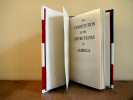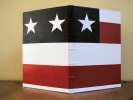Martin posted a blog entry from our hotel room, in the middle of our attendance at Worldcon. I agree with everything he said. The con was exhausting, busy, and an intense family experience. Both kids wigged out from time to time, but also had some really good moments. I saw people from work, from our St Andrews days, and from previous social groups here in Edinburgh. And like Martin, I only made it to one event – in my case, an informal discussion on the future of the book, both as a concept and as a physical object. It was a great discussion, with plenty of debate and no actual conclusions. I wonder whether I would have enjoyed all the programme events I marked out and subsequently missed as much (I doubt it).
But I wasn’t just at the con as an attendee and a parent. I was also there as a bookbinder, and it was the culmination of three very intense weeks in that world for me.
As I noted in a previous entry, I spent a fortnight doing the binds for the Guests of Honour. This was more difficult than I expected. Not only did it take longer (of course – everything always takes longer than you expect it will), but it was also more emotionally challenging than anticipated. Unlike at work, I had no human contact to speak of. I found myself intensely lonely at times. I also found that when things went wrong, I was less able to keep a positive outlook and to develop alternative solutions to problems that arose.
Then we had a houseguest. Liza Groen Trombi, to whom I hadn’t even spoken for nearly fifteen years, came to stay with us for a weekend. We had been close in middle and high school, but gone our separate ways after that – me to Scotland, her to singing in a band, managing restaurants, and finally working as an editor for Locus. My instinct, when we got back in touch, was that I would like her again, and I invited her to stay when she was coming over for Worldcon. I think that was one of the best decisions I’ve made this year. We spent the entire weekend chatting, and I could easily have spent a week or two more listening to her stories and telling a few of my own. She was patient about the fact that I was still binding (and gave very balanced feedback when things went badly). We rode bikes out to Craigmillar Castle, visited Mary King’s Close, drank whisky, and laughed a lot.
And, finally, the Sutherlands went to Worldcon. I was doing two things at once, as a binder. First off, I was co-ordinating the bindings to go to the Guests of Honour. Most of this involved being ready to meet the Publications manager, Steve Cooper, when he had gaps in his schedule and bindings needed signatures put in, or needed to be delivered to recipients. I got to see a lot of the Secure Storage area at the convention during this phase of things. At the same time, I was entered in the Art Show, hoping to sell some of my bindings.
I had four items entered: Dr Jekyll & Mr Hyde, The Hobbit, Frankenstein, and a copy of the Worldcon Souvenir Book. And throughout the convention, I fretted. I went back and back to the art show, checking to see if anyone bid. I worried every time someone had moved a binding. I fussed at Martin (who has the patience of a saint for not throttling me!), at Liza (ditto), and at the boyfriend of the Art Show director, Pat (see previous comments). Two items got bids – the Hobbit and Frankenstein.
In the meantime, on of the Guests of Honour – Jane Yolen – had to go home early for family medical reasons. We arranged a swift presentation to her, and I got a chance to see her reaction to my book. She seemed to like it. (I will post photos of the presentation when I get them).
Thus matters stood this morning. Due to some significant sleep disruptions (thanks, Fi!), my memories of today are best summarised in list form.
- Alex and I, along with much of the Young Adult Fan Activities group, dressed up in masks and goggles and assaulted a panel on the Future of Fandom with inflatable weapons. The point was to remind attendees what the future of fandom really looks like, and perhaps to have a bit of fun on the side. Don’t pity the panel too much – they were forewarned, and forearmed with water pistols.

- Neither unsold binding sold during the after-auction sales. I collected them and left the Art Show. Then I rang Steve, the Publications manager, who immediately offered to buy the Souvenir Book binding. I was delighted, not only because I wanted to sell it, but because I wanted him to have it. After all the work he’d done on the book, I reckoned he would like something special. I understand he has all editions of Splitting Infinity now.
- The person who bought the Hobbit binding – Pat, who had been a friendly face throughout the con – asked me to sign it as the bookbinder. He then tracked down Alan Lee, the illustrator of that edition (and the designer who created the look for Peter Jackson’s Lord of the Rings films), and got him to sign the book while I was there. So I got to meet Alan Lee, an artist whom I respect greatly, not just because he does beautiful work, but also because he is so single-minded about doing it. We talked a bit about the binding, and exchanged email addresses. I even got a photo, with Fi in as well:

- During the closing ceremony for the convention, the co-chairs not only showed the entire audience one of my bindings, they incited them to a round of applause (mostly puzzled, admittedly) for me for doing them.
- I said goodbye to Liza – the only relatively down moment of the day. I miss her already.
Now I get to go back to real life. It’s been a good time, rather like being tossed up and down in a blanket while slightly drunk. In other words, I’ve been to Worldcon.



